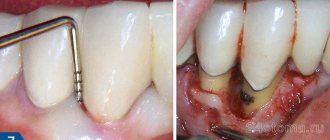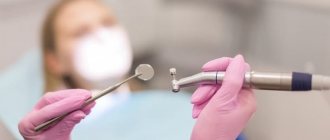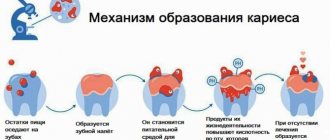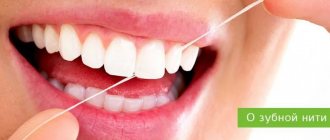Causes of enamel hyperesthesia
Many patients complain of increased sensitivity of teeth after tartar removal. The main reason for such complaints is the exposure of hard tooth tissues that were previously covered with tartar. The deposits partially reduced the impact of irritants - high and low temperatures, sour, sweet and spicy foods. Therefore, after the stone is removed, the enamel reacts more sharply to external factors.
Increased tooth sensitivity is caused by:
- existing diseases of the oral cavity - caries, pulpitis,
- thinning of tooth enamel in the cervical area,
- non-compliance with professional cleaning rules.
To reduce the likelihood of enamel hyperesthesia, have your teeth cleaned only by qualified dentists. Contact only experienced specialists in whose professionalism you are confident.
What is Air Flow
The Air-Flow method can be classified as a mechanical method of brushing teeth. This cleaning is very simple: a water-abrasive solution is supplied into the oral cavity under pressure, which “breaks” and removes hardened plaque in places that are inaccessible to other methods (between the teeth and on the gums). Using the same method, the dentist carefully polishes the enamel, which allows it to be lightened by several tones. For extensive tartar damage to teeth, this method is used as a complement to laser or ultrasonic cleaning.
Complex of symptoms
Increased sensitivity of teeth after cleaning from tartar can manifest itself in different ways. Most often, patients feel:
- discomfort when chewing food and brushing teeth,
- aching pain of varying degrees of intensity when leaving a warm room into the cold, eating hot and cold foods and drinks.
Normally, this condition can persist for 2-7 days. If enamel hyperesthesia does not go away or worsens over time, do not delay your visit to the dentist.
Ultrasound removal
Ultrasound removal
Ultrasound technology has become widespread in modern dentistry, through which tartar removal is carried out as efficiently and painlessly as possible. The technology does not involve contact of the device with the surface of the tooth; enamel cleansing occurs due to directed ultrasonic waves of a certain frequency. The procedure is painless, however, if there is high sensitivity or at the request of the patient, the doctor can use an anesthetic gel.
Despite the popularity of the ultrasound method, it also has some disadvantages:
- an inexperienced dentist can make a number of mistakes that can lead to damage to the gums and enamel;
- increased sensitivity and severe demineralization of teeth can cause pain during and after the procedure;
- the ultrasonic method cannot always be used to remove subgingival stone;
- The ultrasound method is not suitable for patients with a large number of old fillings due to the risk of them falling out.
There are also restrictions on the use of ultrasound for patients with cardiovascular diseases and installed pacemakers. Before the procedure, the doctor will definitely ask the patient about possible contraindications and, if necessary, recommend another method.
Treatment and prevention measures
To reduce the risk of developing hyperesthesia, fluoridation is carried out after professional hygiene with the removal of tartar. Procedure:
- saturates the enamel with useful substances that help strengthen it and restore its structure,
- reduces the likelihood of developing caries.
To avoid enamel hypersensitivity after removing tartar, you must follow the following rules:
- do not eat or drink for two hours after the procedure,
- give up solid and rough foods for a day,
- use a toothbrush with soft bristles,
- Use mouth rinses regularly.
To maintain healthy teeth and gums, professional hygiene with the removal of soft bacterial plaque and tartar should be carried out twice a year.
Problems of dental hypersensitivity during professional oral hygiene
- The use of personal hygiene products for teeth with increased sensitivity.
Unfortunately, modern personal hygiene products for the care of teeth with increased sensitivity provide a short-term effect. And some time after treatment, the patient again shows signs of hyperesthesia. Filling is carried out only if there is a defect in hard tissues. Tooth depulpation is resorted to when all of the above methods of eliminating hypersensitivity are ineffective.
Therefore, professional products such as fluoride-containing gels and varnishes have become widespread for the prevention and treatment of dental hypersensitivity. Gels typically contain low concentrations of fluoride and are recommended for weekly home use for persons over 18 years of age [3].
Unlike gels, fluoride-containing varnishes can remain on the tooth surface for a long time, thus promoting the accumulation of more fluoride in the enamel [2]. This is especially important at a time when demineralization processes predominate. However, when applying conventional fluoride varnishes, calcium fluoride crystals are freely located on the surface and are quickly removed by mechanical abrasion, making the effect short-lived. Therefore, preference should be given to drugs with a longer effect [7].
In our practice, for many years, we have successfully used fluoride-containing products such as VOCO Profluoride Varnish and Bifluoride 12 (VOCO, Germany). Prevention and treatment of hyperesthesia with the help of these drugs are based on closing the mouths of the dentinal tubules with calcium fluoride plugs, which, in turn, block the movement of fluid through them. This leads to a reduction and, ultimately, elimination of the occurrence of unpleasant sensations when exposed to thermal, chemical or tactile stimuli on the teeth.
"VOCO Profluoride Varnish»
is a fluorine-containing varnish based on a special resin (colophonium) containing 5% sodium fluoride. Fluoride ions, together with calcium ions present in the tubules, promote the precipitation of calcium fluoride, which leads to reliable sealing of the dentinal tubules. Along with this, VOCO Profluoride Varnish forms a depot of calcium fluoride on the tooth surface, which protects the tooth from acid attacks, promotes remineralization and the formation of fluorapatite. In addition, xylitol, which has a caryostatic effect, is added to the varnish. Colonium resin provides good adhesion, also on wet surfaces. Therefore, unlike other fluoride-containing preparations, VOCO Profluoride Varnish can be used successfully when it is impossible to dry the surface of the teeth well.
“Bifluoride 12” is a unique transparent fluoride varnish, which is a colorless suspension based on natural tree resin with a pleasant fruity smell and taste. I would like to note that all fluoride varnishes present on the dental market have an active ingredient of sodium fluoride, which has a short-term effect - 2-3 days. The main active components of Bifluoride 12, in contrast, are 6% sodium fluoride and 6% calcium fluoride. It is the presence of calcium fluoride that contributes to better penetrating ability of the drug and provides a long-term therapeutic effect - the release of fluoride occurs over several months.
It is obvious that conventional fluoride varnishes, which are natural resins, do not form a very strong film on the surface of hard tooth tissues, and calcium fluoride crystals are freely located on the surface and are quickly removed by mechanical abrasion, making the effect short-lived [6].
The composition of “Bifluoride 12” includes bioinert Teflon particles, which give it strength properties, and the submicroscopic CaF2 crystals formed during its application are not located on the surface, but directly in the pores of the loosened zone of enamel, dentinal tubules and in the cement of the tooth root. Bifluoride 12 dries quickly, so to obtain long-term adhesion to the enamel it should be applied in a thin layer. To maintain the anti-caries effect, re-coating must be carried out after 3-6 months. Single-layer application of varnish saves the doctor’s time and reduces consumption to a minimum, on average 66% more economical than analogues.
It is important that the problem of dentin sensitivity has led to the creation of a new class of complex drugs aimed at eliminating it: these are dental desensitizers, for example, Admira Protect (VOCO, Germany).
Desensitizers reduce hypersensitivity by sealing the dentinal tubules, that is, they have a “plug-forming” effect [1, 4].
Admira Protect includes several components balanced to achieve maximum desensitizing effect: HEMA (hydroxymethyl methacrylate) and aminofluoride. HEMA acts as a wetting agent, creating the necessary moisture in dentin and preventing the collapse of collagen fibers. This allows the surface layers to be easily impregnated with the main component, developed using a special organic matrix filling technology to thoroughly seal the dentin. Active fluorides help strengthen the structure of hard dental tissues, as they are able to penetrate them and obstruct dentinal tubules, reducing the sensitivity of dentin [2].
Since Admira Protect is a synthetic varnish, it forms a more durable film on the tooth surface compared to preparations based on natural and natural-synthetic resins. It is enough to apply the drug once every 6 months.
Here is a clinical example.
- Patient A., 62 years old, came to the therapeutic dentistry clinic for the purpose of sanitation of the oral cavity. Before the start of sanitation, the patient was recommended to carry out professional hygiene (Fig. 1, 2). Removal of dental plaque was carried out using an ultrasonic device of the piezoelectric type “P Max”, Satelec (Fig. 3); polishing the tooth surface - using an air-abrasive tip “Air-Flow Handy 2”, EMS (Fig. 4). To prevent the occurrence of hypersensitivity in the patient, taking into account slight bleeding of the gums after professional cleaning, Bifluoride 12 applications were used (Fig. 5). After 1 application, her symptoms of dental hypersensitivity disappeared.
rice. 1 Initial clinical situation. rice. 2. View from the lingual surface. rice. 3. Polishing with an air abrasive device. rice. 4. Application “Bifluoride 12”. rice. 5. View after application.
- Patient M., 46 years old, came to the clinic for a preventive examination. It was recommended to carry out professional oral hygiene, to which the patient agreed. After removing dental plaque and polishing the surfaces of the teeth, it was decided to apply the drug “Admira Protect” (Fig. 6-9).
rice. 6. Application from the vestibular surface of the Admira Protect desentitizer, fig. 7. Drying with a jet of air. rice. 8. Photopolymerization of the drug. rice. 9. Final look.
Thus, the use of professional products that reduce tooth sensitivity and seal dentinal tubules is one of the most effective, reliable and fastest ways to eliminate dentin hypersensitivity, both when used independently and in complex treatment of this pathology.
Why is tartar dangerous?
Hard dental plaque is a conglomerate of complex composition, formed from microscopic food debris and iron and phosphorus compounds contained in saliva. In fact, the stone grows into the periodontium, and it is not possible to remove it on your own. First, a thick plaque forms on the teeth, which gradually hardens and turns into stone.
Dental plaque promotes the proliferation of pathogenic flora, resulting in caries, gingivitis, and periodontitis. A favorable environment causes rapid growth of pathogenic bacteria and further damage to the periodontium.
The main signs of the appearance of tartar include:
- noticeable stripes, dots, spots of brown (in shades) color on the enamel;
- unpleasant, “heavy” odor from the mouth;
- internal sensation of enamel roughness.
The smile takes on an unaesthetic appearance, and the smell forces the interlocutor to stay away.
It is especially important to monitor the condition of teeth and promptly remove tartar for those who smoke and drink strong tea and coffee. In this case, nicotine and tannins enter into the process of stone formation - deposits form much faster and acquire a characteristic dark brown color.
Important. The end result of an irresponsible attitude towards tartar is tooth loss.
Why do dental deposits form?
- The abundance of phosphates in saliva due to metabolic disorders.
- Irregular cleaning of the oral cavity, lack of knowledge of proper hygiene, lack of attention to the interdental space.
- Low-quality hygiene products: toothpastes, rinses and brushes from unscrupulous manufacturers who only promise a therapeutic effect.
- Poor heredity is a genetic predisposition to the formation of dental plaque.
- Excessive amount of soft food in your menu. During active chewing, natural plaque removal occurs.
- Dietary and other habits: regular consumption of tea and coffee drinks, smoking leads to darkening of the enamel and the deposition of sediment on the surface of the tooth.
Rehabilitation after cleaning
To prevent gum inflammation from starting after professional teeth cleaning, the patient should be attentive to himself and follow all the doctor’s recommendations regarding rehabilitation. Correct behavior and oral care will allow you to consolidate the results of cleaning for a long time, eliminate inflammation and prevent its complications.











